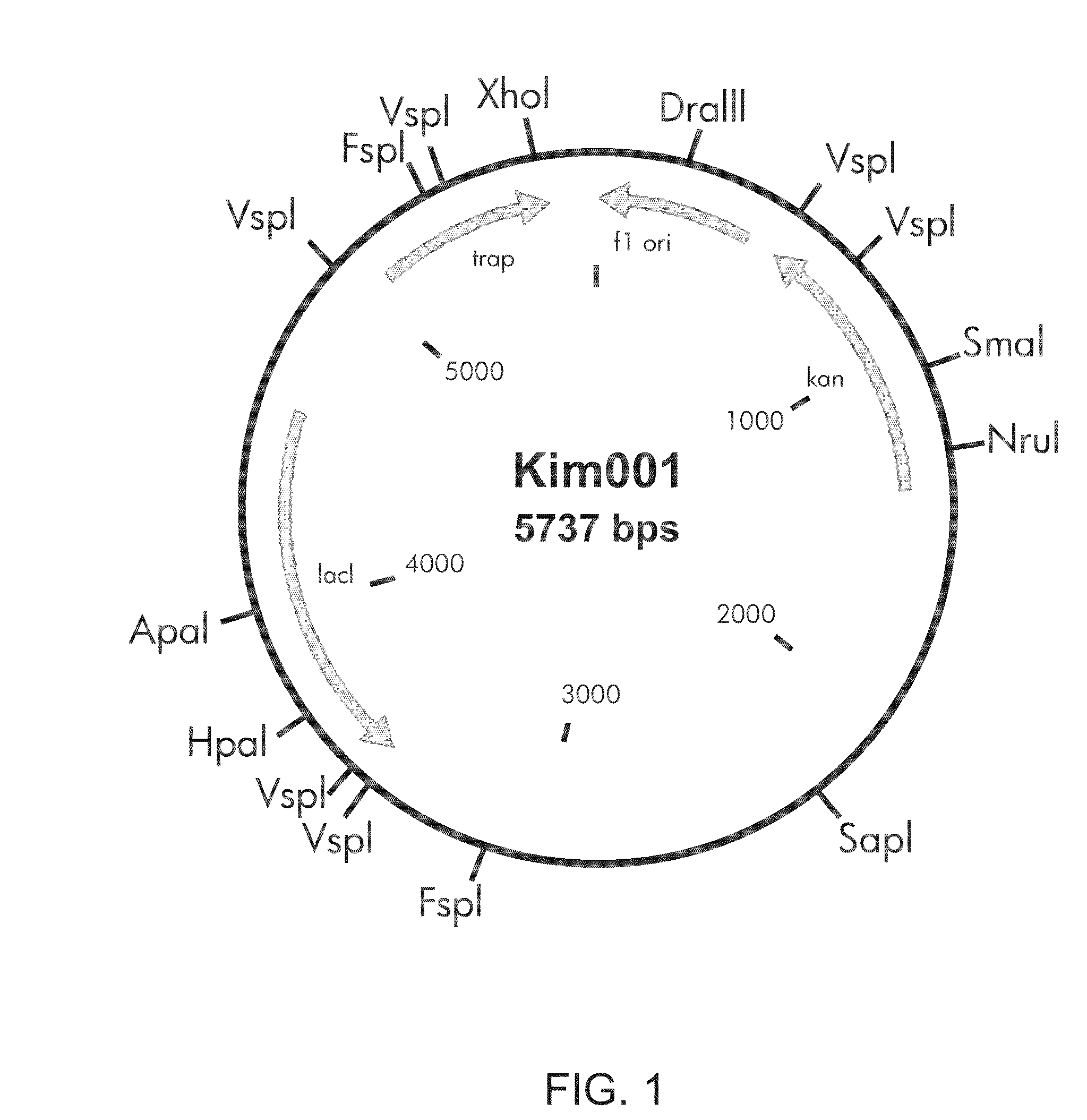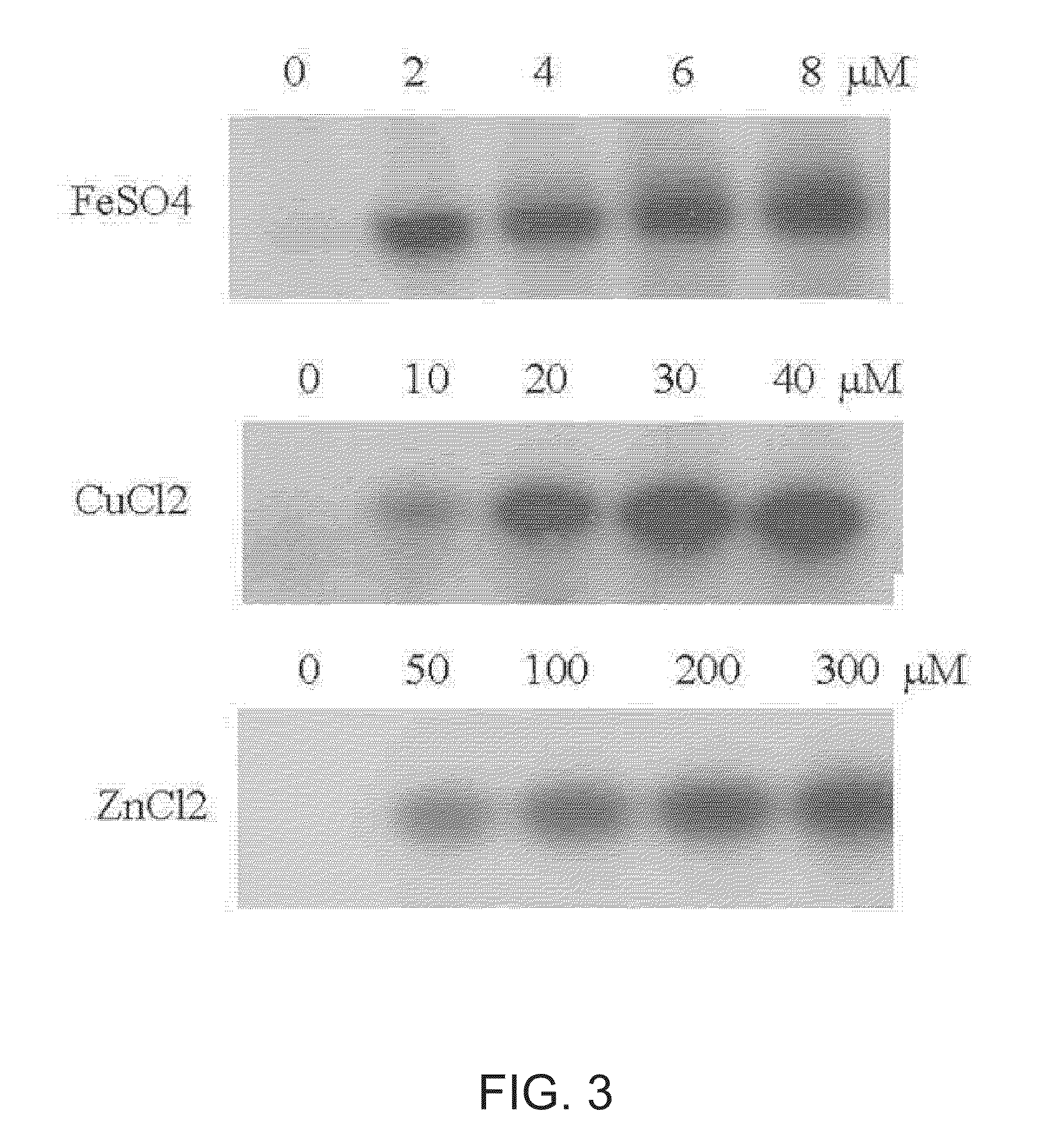Method for in vitro phosphorylation of trap of Staphylococcus aureus and a method for screening the inhibitor of the trap phosphorylation
a technology trap, which is applied in the field of in vitro phosphorylation of trap and the method of screening the inhibitor of the trap phosphorylation, can solve the problems of insufficient disclosure of the mechanism of trap phosphorylation in patent documents or published papers, and a large amount of time and cos
- Summary
- Abstract
- Description
- Claims
- Application Information
AI Technical Summary
Benefits of technology
Problems solved by technology
Method used
Image
Examples
example 1
Cell Culture for Purification of TRAP Protein
[0037]TRAP gene (SEQ ID NO:1, NCBI accession number: NC002952) was cloned into NcoI and XhoI sites of pet28a vector (purchased from Invitrogen). The expression vector Kim001 that can induce to produce an exogenous protein by IPTG and to express the TRAP protein having 6-histidine residues at the C-terminus was constructed (See FIG. 1). Escherichia coli transformant transformed with the expression vector Kim001 was cultured with culture broth for a bacterial expression. The compositions of culture broth are illustrated as follows.
[0038]
TABLE 1Compositions of culture broth in Escherichia coliIngredientsIn 1LPeptone10gYeast extract5gNaCl10gKanamycin50mg
[0039]500 mL of the culture broth was poured into 1 L culture flask and sterilized under 15 atm of pressure at 121° C. for 15 minutes. Then, the E. coli transformant containing the expression vector Kim001 was inoculated into 5 mL of the culture broth, after pre-cultured with an LB / kan culture...
example 2
Purification of TRAP Protein
[0040]The cell supernatant obtained in the Example 1 was loaded onto a Hi trap chelating column (Amersharm Pharmacia) and recovered by using a collection buffer (50 mM Tris-HCL [pH 8.0], 0.5 to 1M imidazole). The resulting proteins were dialyzed to exchange the buffer with 0.5×PBS buffer. The protein sample was stored at 4° C. for an hour after adding 10 mM DTT. Finally, the protein sample was separated with HiLoad XK16 / 60 Superdex 75 gel-filtration column (Amersham-Pharmacia Biotech) by using 20 mM HEPES (pH 7.0) so as to purify the TRAP protein.
example 3
Phosphorylation of TRAP Protein
[0041]The TRAP protein obtained in Example 2 was prepared with each tube according to following compositions of Table 2.
[0042]
TABLE 2Compositions for phosphorylationLanes123456710X phosphate buffer*1 μL1 μL1 μL1 μL1 μL1 μL1 μLTRAP protein (50 μM)1 μL1 μL1 μL1 μL1 μL1 μL1 μLMetal ions**1 μL1 μL1 μL1 μL1 μL1 μL1 μL(200, 2000 μM)P32-ATP (10 μCi)1 μL1 μL1 μL1 μL1 μL1 μL1 μLDW6 μL6 μL6 μL6 μL6 μL6 μL6 μL*Phosphate buffer: 20 mM HEPES [pH 7.0], 2.5% glycerol**Metal ions: MgCl2, ZnCl2, CuCl2, CoCl2, NiCl2, CaCl2, FeSO4
[0043]The protein sample prepared above was reacted at 37° C. for 30 minutes, then mixed with 2× loading dye 10 l (BioRad), and analyzed by performing SDS-PAGE at 150 V for an hour. Afterward, the resulting gel was dried and exposed onto an X-ray film to measure a degree of phosphorylation. The result is illustrated in FIG. 2. In the upper part of FIG. 2, 20 μM metal ions, Mg, Zn, Cu, Fe, Mn, Ni, Co are used in Lane 1 through Lane 7, respectivel...
PUM
| Property | Measurement | Unit |
|---|---|---|
| pressure | aaaaa | aaaaa |
| OD | aaaaa | aaaaa |
| pH | aaaaa | aaaaa |
Abstract
Description
Claims
Application Information
 Login to View More
Login to View More - R&D
- Intellectual Property
- Life Sciences
- Materials
- Tech Scout
- Unparalleled Data Quality
- Higher Quality Content
- 60% Fewer Hallucinations
Browse by: Latest US Patents, China's latest patents, Technical Efficacy Thesaurus, Application Domain, Technology Topic, Popular Technical Reports.
© 2025 PatSnap. All rights reserved.Legal|Privacy policy|Modern Slavery Act Transparency Statement|Sitemap|About US| Contact US: help@patsnap.com



